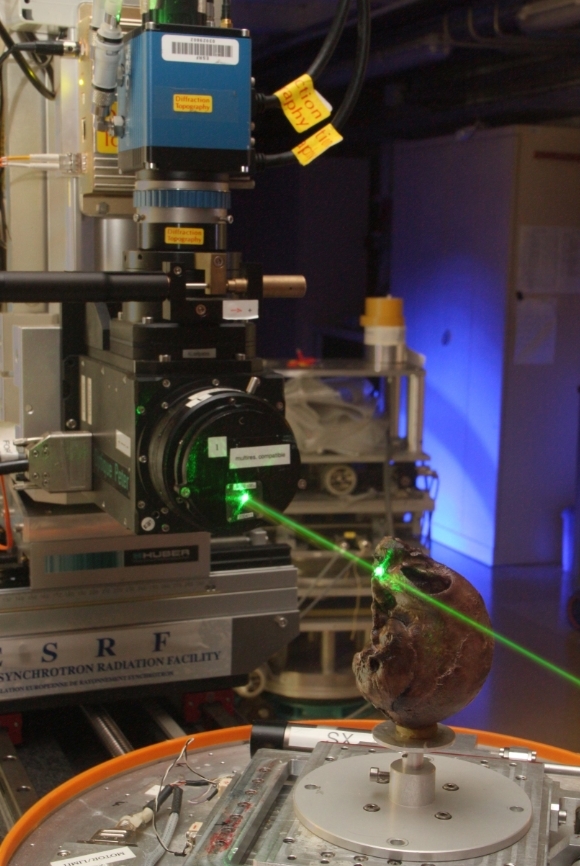Discovery From The Miocene Epoch: A New Species of Primate
A new paper co-authored by Hunter Professor Christopher Gilbert presents an exciting discovery, filling in a gap in the scientific understanding of primate evolution. In August of 2014, Dr. Isaiah Nengo, an anthropology professor at De Aznza College and associate director of the Turkana Basin Institute at Stony Brook University, made a remarkable discovery during a paleontological dig: a fossilized ape cranium, recovered in its entirety from approximately 13 million year old rocks in Kenya. Funded by the Leakey Foundation, the discovery took place in the famous Turkana Basin, an area surrounding Lake Turkana in Northern Kenya. Numerous fossils from that location have provided key clues to our understanding of ape and human evolution in Africa, but most pieces found are bone fragments – useful, but pieces with most of the puzzle missing, and difficult things from which to extrapolate a comprehensive understanding of any species. The newly recovered cranium, the most complete specimen of its kind, presents researchers with unparallelled new opportunities to learn about ancient apes.
Professor Gilbert, a known expert in ape and monkey anatomy and evolution, was a clear resource for Dr. Nengo when the significance of the discovery became clear. Along with his colleague Dr. John Fleagle of Stony Brook University, Professor Gilbert began to analyse the fossil. Their determination – that it was an adolescent ape cranium representing a new species – confirmed the importance of the specimen: it could lead to groundbreaking connections in the study of primate evolution.
 Professor Gilbert, Dr. Fleagle, and Kelsey Pugh, a current Hunter/CUNY Ph.D. student focusing on the evolutionary relationships among fossil apes, performed many of the primary analyses for the paper, spending days combing through the collections of the American Museum of Natural History, taking measurements, performing CT scans, and looking for correlations between existing ape skulls and their new find. Their wide study of living and fossil ape crania led them to an intriguing conclusion: the new species Nyanzapithecus alesi is closely related to the common ancestor of all living apes and humans. The fossil may in fact be the entryway to creating a picture of what the common ancestor of all living apes and modern humans might have looked like. “We are just getting started with understanding the true significance of this amazing fossil, and I’m sure that future studies will highlight other important details as well,” says Professor Gilbert.
Professor Gilbert, Dr. Fleagle, and Kelsey Pugh, a current Hunter/CUNY Ph.D. student focusing on the evolutionary relationships among fossil apes, performed many of the primary analyses for the paper, spending days combing through the collections of the American Museum of Natural History, taking measurements, performing CT scans, and looking for correlations between existing ape skulls and their new find. Their wide study of living and fossil ape crania led them to an intriguing conclusion: the new species Nyanzapithecus alesi is closely related to the common ancestor of all living apes and humans. The fossil may in fact be the entryway to creating a picture of what the common ancestor of all living apes and modern humans might have looked like. “We are just getting started with understanding the true significance of this amazing fossil, and I’m sure that future studies will highlight other important details as well,” says Professor Gilbert.
It was particularly serendipitous that CUNY and Hunter’s Kelsey Pugh happened to be performing research in this particular field at the time of this discovery and was able to contribute significantly to the research, receiving co-author credit for her work. Professor Gilbert is particularly gratified by this: “At Hunter, bright and motivated students can make significant contributions to our research projects and, ultimately, to our understanding of primate evolution.”
The study is already receiving national attention, with publication in Nature, the world’s leading scientific journal and an article in the Washington Post, among others. As the conversation and analysis of this momentous discovery continues, so will our comprehension of our biological past, and the ways in which human life emerged.
For more information click here

 Previous:
A Look at Professor Nari Ward's "G.O.A.T, again" at Socrates Sculpture Park
Previous:
A Look at Professor Nari Ward's "G.O.A.T, again" at Socrates Sculpture Park
